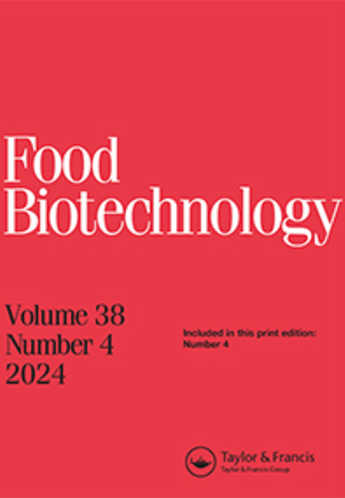The Probiotic Biosurfactant From Levilactobacillus brevis Strain F20 Isolated from a Diary Product with Potential Food Applications
IF 1.6
4区 农林科学
Q4 BIOTECHNOLOGY & APPLIED MICROBIOLOGY
引用次数: 1
Abstract
ABSTRACT In recent years, probiotic bacteria have received considerable attention for biosurfactant (BS) production. In the current study, 80 bacteria were isolated from 70 dairy samples. F20 isolate was selected based on probiotic tests and identified by 16S rRNA method as Levilactobacillus brevis and introduced as valuable candidate for producing biosurfactant. The results of optimization by Central Composite Design (CCD) showed the maximal biosurfactant production at 2.75% of glucose, 3.625% of oil, and 4.25% of yeast concentration. The emulsification index E24 values of 17.14% and 37.5% were obtained in the presence of hexadecane and crude oil, respectively and the biosurfactant production by L. brevis decreased surface tension to 38.05 mN/m. The results obtained TLC and FTIR analysis have confirmed the presence of glycolipid and lipopeptide moieties in the structure of BS. This research indicated that L. brevis strain F20 could be a promising biosurfactant producer in the food and medicine industries.从乳制品中分离的短乳杆菌F20菌株益生菌生物表面活性剂的研究
摘要近年来,益生菌在生产生物表面活性剂方面受到了广泛关注。在目前的研究中,从70个乳制品样本中分离出80种细菌。基于益生菌测试选择F20分离株,并通过16S rRNA方法鉴定为短乳杆菌,并将其作为生产生物表面活性剂的有价值的候选者。通过中心复合设计(CCD)优化的结果表明,在2.75%的葡萄糖、3.625%的油和4.25%的酵母浓度下,生物表面活性剂的产量最大。在十六烷和原油存在下,乳化指数E24分别为17.14%和37.5%,短乳杆菌生产的生物表面活性剂使表面张力降至38.05mN/m。TLC和FTIR分析结果证实了BS结构中存在糖脂和脂肽部分。本研究表明,短乳杆菌菌株F20可能是食品和医药工业中一种很有前途的生物表面活性剂生产商。
本文章由计算机程序翻译,如有差异,请以英文原文为准。
求助全文
约1分钟内获得全文
求助全文
来源期刊

Food Biotechnology
工程技术-生物工程与应用微生物
CiteScore
3.80
自引率
0.00%
发文量
15
审稿时长
>12 weeks
期刊介绍:
Food Biotechnology is an international, peer-reviewed journal that is focused on current and emerging developments and applications of modern genetics, enzymatic, metabolic and systems-based biochemical processes in food and food-related biological systems. The goal is to help produce and improve foods, food ingredients, and functional foods at the processing stage and beyond agricultural production.
Other areas of strong interest are microbial and fermentation-based metabolic processing to improve foods, food microbiomes for health, metabolic basis for food ingredients with health benefits, molecular and metabolic approaches to functional foods, and biochemical processes for food waste remediation. In addition, articles addressing the topics of modern molecular, metabolic and biochemical approaches to improving food safety and quality are also published.
Researchers in agriculture, food science and nutrition, including food and biotechnology consultants around the world will benefit from the research published in Food Biotechnology. The published research and reviews can be utilized to further educational and research programs and may also be applied to food quality and value added processing challenges, which are continuously evolving and expanding based upon the peer reviewed research conducted and published in the journal.
 求助内容:
求助内容: 应助结果提醒方式:
应助结果提醒方式:


